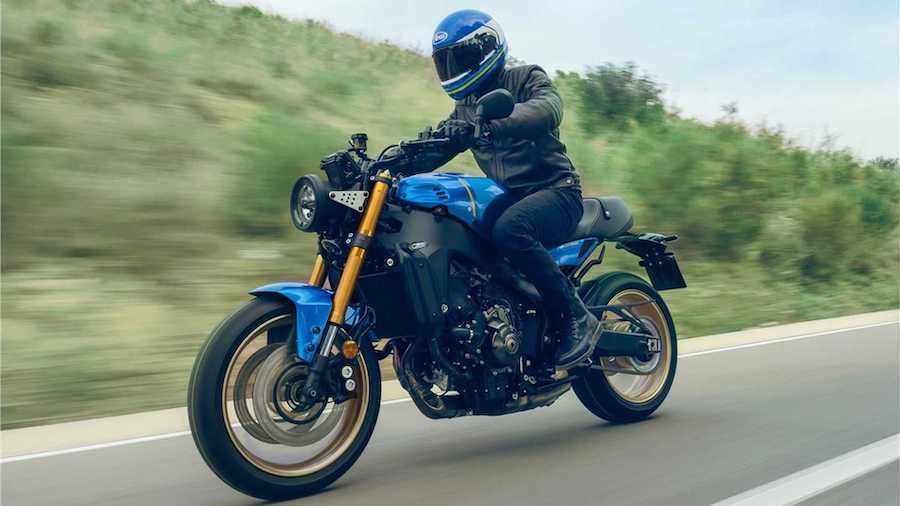Spec Showdown: Kawasaki Z900RS Vs. Yamaha XSR900

Fighting out of the blue corner, wearing blue with gold trim and hailing from Iwata, Japan; known as the Faster Son, the Legend Reborn, it's Yamaha’s XSR900. In the green corner, we have the pride of Minato City, Tokyo. Clad in black and red, the heir to the Z1 throne, the Kawasaki Z900RS.
The XSR900 and Z900RS belong to the same generation of retro-styled streetfighters. The bLU cRU landed the first blow, debuting the CP3-powered XSR at EICMA 2015. Two years later, Team Green countered with its Z1-inspired roadster at EICMA 2017. Both throwbacks have remained rivals in the heavy middleweight class ever since. That is until the XSR900 upped its game in 2022.
Pushing the neo-retro segment beyond the cosmetic confines of the ‘60s and ‘70s, Yamaha drew inspiration from its Grand Prix machines of the ‘80s. Under that shapely gas tank and boxy tail section, a six-axis IMU and R1-derived electronic aids now reside, merging past aesthetics with present-day tech.
With the Z900RS remaining practically unchanged since its 2017 premiere, the betting odds aren’t in Kawi’s favor any longer. If the Green Machine does go down, though, it’ll do so swinging. Ladies and gentlemen, let’s get ready to rumble.
Overview
2023 Kawasaki Z900RS 2022 Yamaha XSR900
Engine: Liquid-cooled, DOHC, 948cc Inline-Four Liquid-cooled, DOHC, 890cc Inline-Triple
Bore and Stroke: 73.4 mm x 56 mm 78 mm x 62.1 mm
Transmission: 6-speed 6-speed
Performance: 109.5 hp/ 72.3 lb-ft 117 hp/ 68.6 lb-ft
Weight (wet): 474 pounds 425 pounds
Price: $11,949 $9,999
Body Blows
Yamaha’s heralded CP3 (Crossplane inline-triple) needed to meet Euro 5 standards by 2021. To reduce the engine’s carbon footprint without sacrificing performance, the Iwata factory bumped its displacement from 847cc to 890cc. Adopted by the XSR900 in 2022, the liquid-cooled, 12-valve triple still whips up 117 ponies (at 10,000 rpm) and 68.6 lb-ft of torque (at 7,000 rpm). An 11.5:1 compression ratio wrings the wundermill of its worth, while the six-speed gearbox and slipper/assist clutch smoothly transfer that power to the pavement.
The Z900RS’s 948cc inline-four cooks with one additional pot but it churns out less sauce, yielding just 109.5 horsepower (at 8,500 rpm) and 72.3 foot-pounds of torque (at 6,500 rpm). The 10.8:1 compression ratio certainly contributes to those pragmatic performance figures, but it also maximizes the mill’s durability and longevity. Similar to its competitor, the Z employs a six-speed transmission and an assist & slipper clutch to lay down the power.
Despite the XSR’s superior power output, the Kawasaki’s peak torque advantage and accessible powerband may actually suit more road riders. Unfortunately, the Z900RS’s 474-pound curb weight doesn’t do it any favors. Tipping the scales at just 425 pounds (wet), the Yamaha easily enjoys the power-to-weight edge. Yes, the RS may jump out of the gates, but the XSR will outrun it by the end of the block. After going to the scorecards, the blue corner wins this round by a split decision.
Fancy Footwork
As the flagship option in Kawi’s RS lineup, the Z900RS predictably suspends its high-tensile steel trellis frame with a fully-adjustable USD front end and a horizontal back-link shock. A 25-degree rake adds agility to the equation, while a 57.9-inch wheelbase optimizes stability at a faster clip.
Yamaha matches that nimble nature with the XSR900’s fully adjustable suspension and 25-degree steering head but its 58.9-inch wheelbase slows turn-in rate (by comparison). On the contrary, some could argue that Yamaha’s Controlled Filling (CF) die-cast aluminum frame delivers finer feel and feedback due to its balanced longitudinal, lateral, and torsional rigidity. Of course, that isn’t something a testable metric in a Spec Showdown, so Kawi claims this round by a literal inch.
Technical Knockout
If the first two rounds were hotly-contested, the final round has the makings of a beatdown. When Yamaha integrated its R1-derived electronics suite into the 2022 XSR900, it joined the likes of the MV Agusta Superveloce and Triumph Speed Triple 1200 RR in the neo-retro market. Unlocking cornering ABS and lean-sensitive traction control, the six-axis IMU takes the XSR to a whole new stratum of performance and safety.
Yamaha doesn’t pull its punches either, adding slide control, lift (wheelie) control, and engine brake control for the utmost customization. The XSR900 also benefits from a full-color TFT display, albeit crammed into a 3.5-inch layout. The Z900RS pales in comparison. Sure, it flaunts retro-appropriate analog speedo and tach gauges but the reverse LCD display seems dated by today’s standards. Outside of standard ABS, the Kawi only offers traction control, making the Yamaha the clear favorite in this contest.
Conclusion
Based on the last-round shellacking, it seems like the Yamaha XSR900 reigns supreme, right? Not so fast. More than any other segment in motorcycling, looks matter when it comes to modern-classics. While the 2022 XSR900 improves on its predecessor’s fit and finish, the blockish ‘80s Grand Prix style may not be everyone’s cup of tea. Conversely, the Z900RS is universally hailed as a legitimate head-turner. Looks may be subjective, but they certainly factor into the Z’s appeal.
Now, for something that’s not so subjective: price. Yamaha sets the 2022 XSR900’s MSRP at just $9,999. That’s an unbeatable performance and technological one-two punch for your buck, even if you’re not floored by the revamped design. On the other hand, Kawasaki lists the 2023 Z900RS at $11,949, a hefty markup considering its shortcomings. Based on the specs alone, we have to award the victory to the Yamaha XSR900. But, like most motorcycle-buying experiences, your head—and your heart—will factor into the purchasing process.
Related News
